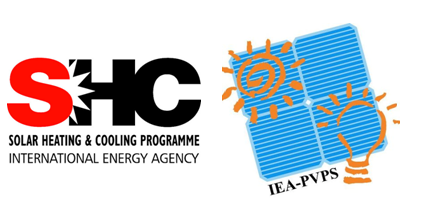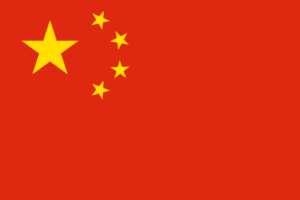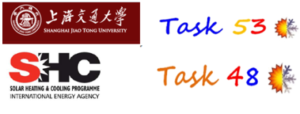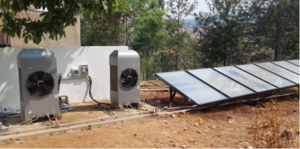Solar Cooling 2.0: New Generation Growing Up
October 1, 2015
 The workshop New Generation Solar Cooling & Heating Systems held in Rome, Italy, on 23 September 2015 was the opportunity to check the status of both research on and market developments in solar cooling technology. The half-day event, which had about 40 participants, was jointly organised by Task 53 of the IEA Solar Heating & Cooling Programme and the German Eastbavarian Institute for Technology Transfer, OTTI e.V., and took place a day before the start of OTTI’s 6th International Conference on Solar Air-Conditioning. Above all, the workshop provided a platform for presenting the first outcomes of the international research cooperation TASK 53 entitled New Generation Solar Cooling & Heating Systems, which was launched in March 2014, will end in 2017 and involves 10 countries, some from outside Europe (see the attached introductory presentation).
The workshop New Generation Solar Cooling & Heating Systems held in Rome, Italy, on 23 September 2015 was the opportunity to check the status of both research on and market developments in solar cooling technology. The half-day event, which had about 40 participants, was jointly organised by Task 53 of the IEA Solar Heating & Cooling Programme and the German Eastbavarian Institute for Technology Transfer, OTTI e.V., and took place a day before the start of OTTI’s 6th International Conference on Solar Air-Conditioning. Above all, the workshop provided a platform for presenting the first outcomes of the international research cooperation TASK 53 entitled New Generation Solar Cooling & Heating Systems, which was launched in March 2014, will end in 2017 and involves 10 countries, some from outside Europe (see the attached introductory presentation). The R&D road to competitiveness
The recent roadmap for solar heating and cooling, which was developed by the IEA, calls for solar cooling to cover at least 17 % of total cooling demand by 2050. Over the last ten years, however, development has not been as rapid and effective as had been expected. Only a few special cases showed the technology to be economically competitive and to have some market appeal. The vast majority of potential applications included a solution which still has too long of a payback period and therefore can only be installed only if incentives are high, as has been the case with research and demo projects.
“Due to hydraulic complexity and high investment costs, the first generation of solar cooling systems has not proven to be competitive,” Daniel Mugnier, Operating Agent of Task 53, made clear at the start of the workshop in Rome. “Because of this, we cannot yet talk of a marketable technology but rather of the need for intense R&D in order to develop a new generation of innovative systems for Solar Cooling 2.0.”
Another relevant issue discussed at the workshop was the chance of cooling and air-conditioning shifting increasingly towards large-scale systems, as has already happened with other energy sector applications. Such solutions, potentially with solar thermal energy for both cooling and heating, could also include small, medium and large district cooling grids. One additional feature of these plants should be the parallel coexistence of different energy sources, both electrical and thermal, to supply energy for cooling.
Although the special focus of the solar cooling segment is on newbuilds, the use of this technology in existing premises is not impossible, but will have to satisfy some requirements, such as the availability of sufficient roof space (an issue in modern cities with many high-rise buildings) and the possibility of adapting the existing cooling distribution system to incorporate solar energy supply.
Compact and easy to install Solar Cooling 2.0
How will such a new generation of innovative systems look like? Certainly, Solar Cooling 2.0 should be highly compact and easy to install, which means great compatibility for a direct combination with chillers. Only such a plug-and-play approach can turn solar cooling into a valuable competitor of technologies like heat pumps.
One additional must is the need to develop new standards and to have more monitoring data available, because, first of all, new prospects want to know how the systems are performing in real-life application. Another message coming from the workshop is: ‘Keep it simple’. A fine example of this philosophy is the relatively small (130 m²) solar plant in Banyuls-sur-Mer, France, at which the produced heat is used to air-condition 4,500 m² of wine storage: The system has been operating for about 25 years without major failures, primarily because of its simplicity.
The good news is that the industry is progressing. In his presentation, Wei Zheng from the large and well-known Japanese chiller manufacturer Yazaki announced that his company was working on improving some of their chillers to make them more suitable for solar use (see the attached presentation). So, it is no longer only the solar industry approaching the cooling system manufacturers, but chiller producers, in turn, are now trying to be compatible with solar! The main technical issue Yazaki is working on: allowing their chillers to operate at lower temperatures and with lower flow rates to increase solar field efficiency. An example shown by Yazaki reported an increase of the solar fraction from less than 50 % to 66 % thanks to such enhancements.
Photovoltaic as partner or competitor?
A peculiarity of Task 53 is that it is dealing with solar PV cooling as well, and that this is happening in collaboration with another IEA research programme, the Photovoltaic Power Systems Programme (PVPS). Gaëtan Masson, Operating Agent of PVPS Task 1, says it quite clearly: “For our business plans to work, with no more feed-in incentives available in key countries, PV has to maximise self-consumption and cooling demand could fit to such a need. That is the main reason why compact units with PV modules directly coupled to a cooling machine are at their position in the market right now.” (see the attached presentation by Masson)
So, is PV a collaboration partner or a merciless competitor of solar thermal in the struggle for prospects? When being asked that specific question, Mugnier explained his view as follows: PV will be the main technology for small to medium single-user cooling applications, for instance, mono or multi-split systems, whereas regarding large-scale application (industry, grids), solar thermal could still be the best option to go for.
More information:


